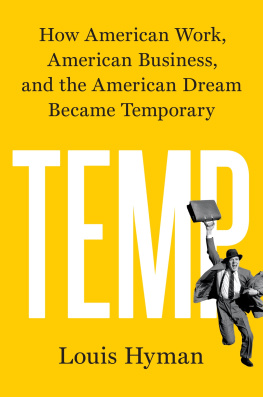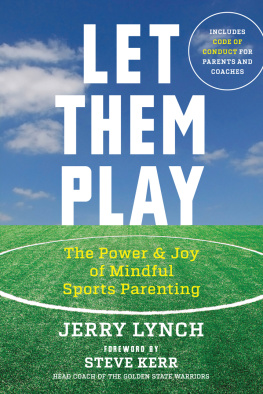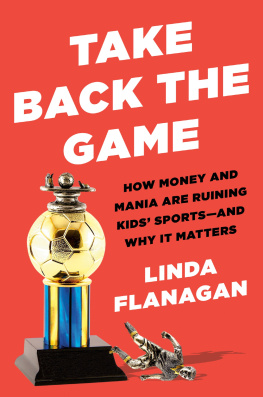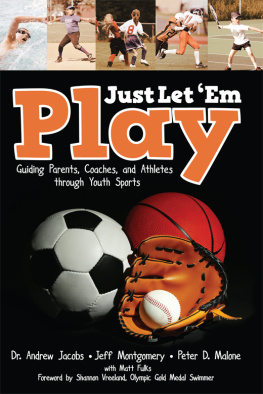The Most Expensive Game in Town
The Rising Cost of Youth Sports and the Toll on Todays Families
Mark Hyman
Beacon Press
Boston
To Evelyn Hyman, with love and thanks for all those rides to practice.
Contents
Introduction
Greg Centracchio and Brian Bushwell would be the first to tell you that they stumbledactually, wanderedinto their present line of work.
They have been friends since the late 1980s, when they met as students at the University of Hartford in Connecticut. Back then, Centracchio and Bushwell were teammates on the varsity baseball team, a good if not great Hawks squad that won a few more games than it lost. When they graduated, they discussed going into business together. But through the years the college friends never found a project that both could enthusiastically get behind.
Until 2005, when Centracchio got a phone call from his friend. There was a distinct edge in Bushwells voice, as if hed hit on something big but wasnt sure how big.
Centracchio remembers his friend posing a question that couldnt have been more unexpected: Greg, what if we hang a camera on a backstop? Bushnell had just returned from a trip to a kids baseball game near his home in New Jersey. For most of the visit, hed observed parents kibitzing on the edges of the field and taking seats in the bleachers. And hed thought about the adults who would have loved to be there but couldnt: moms stuck in board meetings, grandparents, aunts, and uncles all living a time zone away.
For those adults, Bushnell suggested, the answer might be a webcam. Nothing elaborate, just an unblinking eye staring down from the chain-link fence behind home plate to record each pitch and swing, and stream the video to a website. Then charge $15 a month for fans of the little players to log in on their laptops. Centracchio, like his business partner a father and a sports nut, remembers what he was thinking as Bushnell explained this simple and yet ingenious plan: Great idea.
It took two years for the entrepreneurs to launch their website, which they named Youth Sports Live, and another two or three for the kinks to be worked out. The partners discovered, among other things, that not all webcams are weatherproof or foul-ball-proof. Nor is it a simple matter to stream multiple youth sports games simultaneously and reliably to the Web.
Now the years of troubleshooting appear to be paying off for Centracchio and Bushnell. Many youth leagues are embracing Youth Sports Live as a boon to parents and a new way to make money. The company contributes a portion of each new subscription fee paid back to the leagues, usually 15 percent. National sports organizations are also getting on board: Little League Baseball, Cal Ripken Baseball, and Dixie Youth Baseballwith millions of telegenic kids circling the basesall have sponsor deals with Youth Sports Live. In the future, Centracchio and Bushnell plan to expand beyond baseball and softball to kids soccer, basketball, and a half dozen other sports.
It all sounds so exciting, so cutting-edgeuntil you speak with Frank Smoll. In 2010, I did. I was writing an article for the New York Times about kids sports and technology, a piece that told the stories of a few pioneering companies, including Youth Sports Live. I wanted perspective on how children are affected by such inventions and was confident that Smoll would deliver. A professor of child psychology at the University of Washington in Seattle, Smoll and colleague Ronald Smith have written books, developed coaching protocols, and authored countless scholarly articles on sports and child development.
Smoll hadnt heard about Youth Sports Live. As I explained the website to him, it was clear that the news I was bringing was less than welcome to the professor. Its definitely over the top, he tells me soberly. Im sure the people behind this company have good intentions. I imagine theyre thinking, Look, we can have parents and grandparents get close to the situation, really be involved in sports for these kids. They dont realize theyre imposing a system on children without knowledge of the ramifications. You say its a good program for kids, but that doesnt mean it is.
Smoll and I chatted on, with the professor explaining the surprising (to me) number of ways that a webcam can damage a childs experience in sports: kids feeling under the gun to perform, judged by an audience of unseen fans, unsettled by a surveillance camera high above. Only clinical research would tell the true effect of Youth Sports Live and inventions like it, Smoll told me. But one outcome might be that some children would up and quit sports. It heightens the potential for kids to feel pressured, he concluded. When the fun disappears, so do they.
After conducting this interview and others for this book, I began to think about the subtle if critical difference between improving sports for kids and improving sports for kids for adults. For all its appeal as a business spinning off revenues for its founders and for youth leagues, is Youth Sports Live a good idea for children? If not, or even if the matter is in doubt, should we be embracing it?
There has never been a better time to start a business selling sports to children and their parents. The reasons are simple enough: There are more children playing organized sports than ever before41 million according to the latest estimates. There are more parents and supervising adults invested in the idea that spending on that one extra thinga travel team, a lacrosse stick, a private lessoncan make a difference in turning their kids into polished athletes. And, of course, there are many more entrepreneurs eager to meet this growing demand.
This book argues that commerce is damaging youth sports. Not all commerce, of course. And, as in the case of Youth Sports Live, not always in ways that are intentional or even evident to those who are selling or buying. Yet commercialization is gnawing away at what is good and valuable about sports for children.
Sports sociologist Jay Coakley, professor emeritus at the University of Colorado, Colorado Springs, and a prolific writer and editor on the subject of kids, adults, and sports, puts it well: Any time the livelihood of adults depends upon kids doing certain things in sports, there is potential for abuse. Imagine you run a gymnastics gym and have an eleven-year-old who is really good and going to be your marquee star. She comes to you and says her knee hurts. You might be tempted to give her a couple of Advil instead of telling her to sit out for a week, he says.
Thats one not-insignificant way that commercialization threatens what is best about kids sports. Others are these:
Commercialization is damaging the concept of a level playing field in terms of childrens access to equipment and coaching. Of course, the field has never been perfectly level, but the era of private coaches, train-with-the-stars summer camps, and the like has only exacerbated the situation. Coakley calls it the privatization of youth sports and believes this phenomenon has been disastrous for children.
Commercialization is obscuring the life lessons of youth sports: striving, succeeding, and failing, always on the merits. In an age when everything seems to be for salehigher SAT scores, a slot on a college sports team, or your childs name in lightsweve been brainwashed to believe that excellence in sports is a product on a shelf, like laundry soap or a necktie. It isnt, and commercialization is drowning out a vital truth.
Commercialization is the bait that has attracted some very large fish to the pond we call youth sports. For shareholders of Nike, Under Armour, Disney, and other publicly traded companies, the demands for apparel, equipment, and sports drinks add tens of millions of dollars to the bottom line. For kids, that can mean trouble. Gatorade may be the most guzzled beverage on the planet, or it seems so on the sidelines and in the dugouts of youth sports games. Gatorade does all it can to promote its flavored drinks as thirst-quenching and a key to proper hydration. That isnt the whole story. Pediatricians remind us that such drinks fill kids with calories they dont need and can contribute to tooth decay. Or consider Nike. It seems to be committed to turning football into a year-round sport. For good reason: when it becomes one (if it isnt already), Swoosh executives will sell more cleats, cross-trainers, workout gear, and the rest. But is full-time football good for kids? Ive never spoken with a pediatrician, neurologist, or orthopedic surgeon who thinks so.















